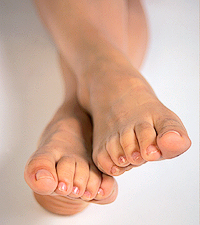Bunions
Bunions & Bunion Surgery
Do you have a painful bunion? Do you think you need surgery? Our Podiatrists can help you evaluate the progression of your bunion. Then we will review with you both conservative treatments and surgical options to help relieve your pain. Review the information below then call us for an appointment so you can be active again.
Bunions
If the joint that connects your big toe to your foot has a swollen, sore bump, you may have a bunion. More than half the women in America have bunions, a common deformity often blamed on wearing tight, narrow shoes, and high heels.
Bunions are often described as a bump on the side of the big toe. But a bunion is more than that. The visible bump actually reflects changes in the bony framework of the front part of the foot. With a bunion, the big toe leans toward the second toe, rather than pointing straight ahead. This throws the bones out of alignment—producing the bunion’s “bump.”
Bunions are a progressive disorder. They begin with a leaning of the big toe, gradually changing the angle of the bones over the years and slowly producing the characteristic bump, which continues to become increasingly prominent. Usually the symptoms of bunions appear at later stages, although some people never have symptoms.
Conservative Treatment for Bunion Pain
Sometimes observation of the bunion is all that's needed. A periodic office evaluation and x-ray examination can determine if your bunion deformity is advancing, thereby reducing your chance of irreversible damage to the joint. In many other cases, however, some type of treatment is needed. Early treatments are aimed at easing the pain of bunions, but they won't reverse the deformity itself. These options include:
Changes in shoewear:
Wearing the right kind of shoes is very important. Choose shoes that have a wide toe box and forgo those with pointed toes or high heels which may aggravate the condition.
Padding:
Pads placed over the area of the bunion can help minimize pain. You can get bunion pads from us or purchase them at a drug store.
Activity modifications:
Avoid activity that causes bunion pain, including standing for long periods of time.
Medications:
Nonsteroidal anti-inflammatory drugs (NSAIDs), such as ibuprofen, may help relieve pain.
Icing:
Applying an ice pack several times a day helps reduce inflammation and pain.
Injection therapy.:
Although rarely used in bunion treatment, injections of corticosteroids may be useful in treating the inflamed bursa (fluid-filled sac located in a joint) sometimes seen with bunions.
Orthotic devices:
In some cases, custom orthotic devices may be provided by us.
When is Surgery Needed?
When the pain of a bunion interferes with daily activities, it's time to discuss surgical options with us. Together we can decide if surgery is best for you.
Recent advances in surgical techniques have led to a very high success rate in treating bunions. A variety of surgical procedures are performed to treat bunions. The procedures are designed to remove the "bump" of bone, correct the changes in the bony structure of the foot, as well as correct soft tissue changes that may also have occurred. The goal of these corrections is to eliminate pain.
In selecting the procedure or combination of procedures for your particular case, the surgeon will take into consideration the extent of your deformity based on the x-ray findings, your age, your activity level, and other factors. The length of the recovery period will vary, depending on the procedure or procedures performed.
Bunionette
If you have a painful swollen lump on the outside of your foot near the base of your little toe, it may be a bunionette (tailor's bunion). You may also have a hard corn and painful bursitis in the same spot. A bunionette is very much like a bunion. Wearing shoes that are too tight may cause it. Get shoes that fit comfortably with a soft upper and a roomy toe box. In cases of persistent pain or severe deformity, surgical correction is possible.

